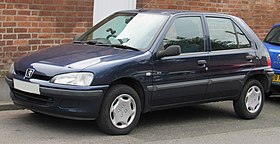
Back Peugeot 106 Afrikaans بيجو 106 Arabic Пежо 106 Bulgarian Peugeot 106 Catalan Peugeot 106 Czech Peugeot 106 Danish Peugeot 106 German Peugeot 106 Greek Peugeot 106 Esperanto Peugeot 106 Spanish
This article needs additional citations for verification. (November 2008) |
| Peugeot 106 | |
|---|---|
 2001 Peugeot 106 XN (Phase II) | |
| Overview | |
| Manufacturer | Peugeot |
| Production | 1991–2003 (2,798,200 units) |
| Assembly | Mulhouse, France Aulnay-sous-Bois, France La Marsa, Tunisia (STAFIM) |
| Body and chassis | |
| Class | Supermini (B) |
| Body style | 3-door hatchback 5-door hatchback |
| Layout | Front-engine, front-wheel-drive |
| Related | Citroën Saxo Citroën AX |
| Powertrain | |
| Engine | |
| Electric motor | 11 kW/15 hp (electric) |
| Dimensions | |
| Wheelbase | 2,385 mm (93.9 in) (1991–96) 2,387 mm (94.0 in) (1996–2003) |
| Length | 3,564 mm (140.3 in) (1991–96) 3,678 mm (144.8 in) (1996–2003) |
| Width | 1,590 mm (62.6 in) (1991–96) 1,594 mm (62.8 in) (1996–2003) 1,610 mm (63.4 in) (GTi) |
| Height | 1,369 mm (53.9 in) (1991–96) 1,380 mm (54.3 in) (1996–2003) 1,357 mm (53.4 in) (GTi) |
| Curb weight | 790–950 kg (1,741.7–2,094.4 lb) |
| Chronology | |
| Predecessor | Peugeot 205 Peugeot 104 |
| Successor | For nomenclature: Peugeot 107 For 106 Électrique: Peugeot iOn |
The Peugeot 106 is a supermini produced by French automaker Peugeot between 1991 and 2003. Launched in September 1991, it was Peugeot's entry level offering throughout its production life, and was initially sold only as a three-door hatchback, with a five-door hatchback joining the range in the beginning of 1992. Production ended in July 2003.
For the first year of production, the 1.0 and 1.1 petrol engines came with a carburettor, but were replaced by fuel injected engines from the end of 1992, as a result of EEC emissions regulations.